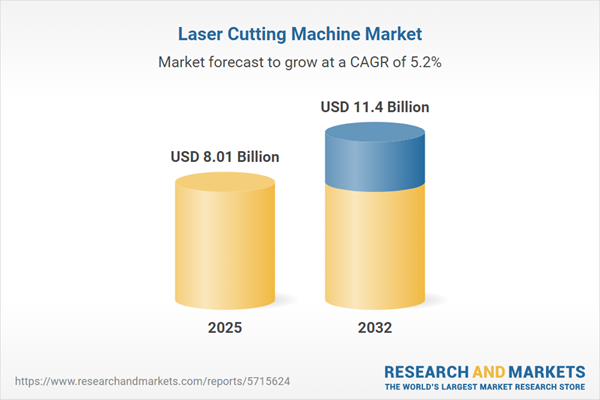Speak directly to the analyst to clarify any post sales queries you may have.
The laser cutting machine market is advancing as manufacturers adopt smarter, more efficient solutions to address precision, speed, and sustainability demands across key industry sectors. This evolution underpins a broader digital transformation in global manufacturing environments.
Market Snapshot: Laser Cutting Machine Market Growth and Trends
The global laser cutting machine market has demonstrated steady growth, rising from USD 7.60 billion in 2024 to USD 8.01 billion in 2025, and is projected to reach USD 11.40 billion by 2032, driven by a CAGR of 5.18%. Robust adoption is observed across industries, characterized by the transition toward digital fabrication and automated production methods, aligning with the core requirements of precision manufacturing and enhanced operational efficiency.
Scope & Segmentation
This research offers a comprehensive evaluation across core market divisions and regional performance drivers. The study systematically breaks down the laser cutting machinery landscape by technology, application, and geography to clarify opportunities for growth and investment.
- Laser Types: Carbon Dioxide Laser (Continuous Wave, Pulsed), Fiber Laser (Continuous Wave, Pulsed), NdYAG Laser
- Materials Processed: Metals (Aluminum, Mild Steel, Stainless Steel), NonMetals (Acrylic, Wood)
- Power Ranges: 1000 To 3000 Watt, Above 3000 Watt, Up To 1000 Watt
- Applications: Aerospace, Automotive, Electronics, Medical
- Control Types: CNC, Manual
- Geographic Regions & Countries: Americas (United States, Canada, Mexico, Brazil, Argentina, Chile, Colombia, Peru), Europe, Middle East & Africa (United Kingdom, Germany, France, Russia, Italy, Spain, Netherlands, Sweden, Poland, Switzerland, United Arab Emirates, Saudi Arabia, Qatar, Turkey, Israel, South Africa, Nigeria, Egypt, Kenya), Asia-Pacific (China, India, Japan, Australia, South Korea, Indonesia, Thailand, Malaysia, Singapore, Taiwan)
- Leading Manufacturers: TRUMPF GmbH + Co. KG, Bystronic AG, Amada Co., Ltd., Yamazaki Mazak Corporation, Prima Industrie S.p.A., LVD Company nv, Han’s Laser Technology Industry Group Co., Ltd., Mitsubishi Electric Corporation, Salvagnini Italia S.p.A., Coherent, Inc.
Key Takeaways: Strategic Insights for Decision-Makers
- Laser cutting machinery now plays a central role in efficient production for diverse applications, with advanced systems supporting increasingly complex assembly requirements and higher precision standards.
- Technological integration, including real-time monitoring and process automation, enhances reliability, supports continuous operation, and meets strict quality expectations.
- Market dynamics reveal shifting priorities: high-efficiency fiber lasers are replacing legacy solutions, reducing both operational costs and energy footprints.
- Sustainability and supply chain resiliency are fostering greater regionalization, with manufacturers forging new local partnerships to optimize delivery and manage cost variability.
- Flexible control architectures allow end users to choose between full automation and manual operation based on production needs, increasing versatility across sectors.
Tariff Impact: Evolving Supply Chains and Pricing Strategies
The implementation of new tariffs in the United States in 2025 led to higher input costs for manufacturers relying on imported optical components and consumables. Organizations responded by localizing sourcing and establishing strategic partnerships to maintain competitive pricing and stabilize lead times. While these measures introduced short-term challenges, such as longer delivery schedules and capital reprioritization, they also spurred increased regional diversification and improved resilience against policy shifts. Many stakeholders have diversified procurement and entered outcome-based long-term agreements to distribute expenditure and preserve financial predictability.
Methodology & Data Sources
Analysis is grounded in a combination of primary interviews with industry leaders, structured surveys validated by independent secondary sources, and expert panel reviews. This robust approach ensures all insights are supported by verified market data and real-world perspectives from technology users and manufacturers.
Why This Report Matters
- Supports confident investment and procurement decisions through in-depth segmentation and competitive intelligence across regions and technologies.
- Equips executive leaders to respond proactively to tariff changes, new technology adoption, and shifting sustainability mandates in the laser cutting machine sector.
- Enables the development of data-driven strategies, from production planning to vendor and partner selection, underpinned by actionable market insights.
Conclusion
The laser cutting machine market is on a trajectory of sustained growth, informed by technological innovation, evolving industry requirements, and new supply chain strategies. Organizations positioned with the right insights, partnerships, and flexible technologies will capture emerging opportunities in this precision-focused environment.
Additional Product Information:
- Purchase of this report includes 1 year online access with quarterly updates.
- This report can be updated on request. Please contact our Customer Experience team using the Ask a Question widget on our website.
Table of Contents
3. Executive Summary
4. Market Overview
7. Cumulative Impact of Artificial Intelligence 2025
Companies Mentioned
The companies profiled in this Laser Cutting Machine market report include:- TRUMPF GmbH + Co. KG
- Bystronic AG
- Amada Co., Ltd.
- Yamazaki Mazak Corporation
- Prima Industrie S.p.A.
- LVD Company nv
- Han’s Laser Technology Industry Group Co., Ltd.
- Mitsubishi Electric Corporation
- Salvagnini Italia S.p.A.
- Coherent, Inc.
Table Information
| Report Attribute | Details |
|---|---|
| No. of Pages | 190 |
| Published | October 2025 |
| Forecast Period | 2025 - 2032 |
| Estimated Market Value ( USD | $ 8.01 Billion |
| Forecasted Market Value ( USD | $ 11.4 Billion |
| Compound Annual Growth Rate | 5.1% |
| Regions Covered | Global |
| No. of Companies Mentioned | 11 |









